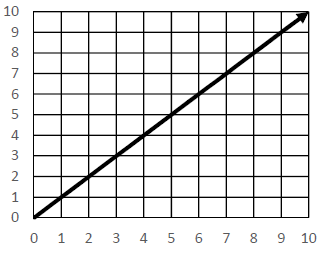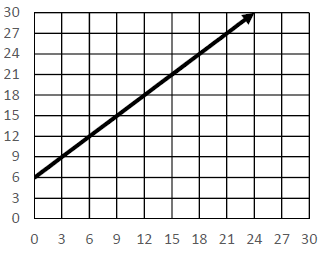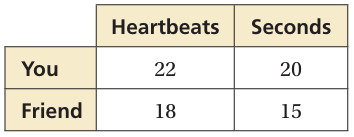PROPORTIONAL RELATIONSHIP
If all the ratios of the variables are equivalent, then those two quantities are in proportional relationship.
In other words, in proportional relationships, one variable is always a constant value times the other variable.
That constant value is called the constant of proportionality.
- Check if the function represents proportional relationship
- Check if the graph represents proportional relationship
- Check from the table
- Check from the statement.
Problem 1 :
Determine if each of the following equations represents a proportional or nonproportional relationship.
(i) d = 65t
(ii) p = 0.1s + 2000
(iii) n = 450 − 3p
(iv) 36 = 12d
A linear relationship is a proportional relationship when y/x is constant. Otherwise, the linear relationship is nonproportional.
Solution :
(i) d = 65t
Since the given equation is in the form of y = kx, it is a proportional relationship.
Constant of proportionality = 65.
(ii) p = 0.1s + 2000
0.1s is added by 2000. So, it is not in proportional relationship.
(iii) n = 450 − 3p
By rewriting as, n = -3p + 450
-3p is added by 450. It is not a proportional relationship.
(iv) 36 = 12d
There is no relationship between two variables. So, there is no proportional relationship.
From the Table
Problem 2 :
Determine if the linear relationship represented by each table is a proportional or nonproportional relationship.
(i) When x = 2, y = 30
When x = 8, y = 90
Solution :
When x = 2, y = 30
Constant of proportionality (k) = y/x
k = 30/2 ==> 15
When x = 8, y = 90
k = 90/8 ==> 45/4
Since constant of proportionality are not equal, it is not in proportional relationship.
(ii)

Solution :
When x = 5, y = 1
Constant of proportionality (k) = y/x
k = 1/5
When x = 40, y = 8
k = 8/40 ==> 1/5
Since constant of proportionality are equal, it is in proportional relationship.
From the Statement
Problem 3 :
Determine which situation is a proportional relationship and which situation is a nonproportional relationship.
(i) The cost for Test Prep Center A is $20 times the number of hours that you attend.
Solution :
Let C be the cost for test preparation center A.
h be the number of hours.
C = 20h
It is a proportional relationship.
(ii) The cost for Test Prep Center B is $25 an hour, but you have a $100 coupon that you can use to reduce the cost.
Solution :
C = 100 - 25h
It is non proportional relationship.
From the Graph
Problem 4 :
Determine if each relationship is a proportional or nonproportional situation.
(i)

Solution :
Since the line passes through the origin, it is a proportional relationship.
(ii)

Solution :
Since the line does not passes through the origin, it is a non proportional relationship.
Problem 5 :
You swam for 16 minutes and completed 20 laps. You swam your first 4 laps in 2.4 minutes. How long does it take you to swim 10 laps?
Solution :
Compare unit rates to determine whether the number of laps is proportional to your time. If it is, then you can use ratio reasoning to find the time it takes you to swim 10 laps.
Time taken to complete 20 laps = 16 minutes
Time taken to complete 1 lap = 16/20
= 4/5
= 0.8 lap per minute
Time taken to cover 4 laps = 2.4 minutes
Time taken to complete 1 lap = 2.4/4
= 0.6 laps per minute
The number of laps is not proportional to the time. So, you cannot use ratio reasoning to determine the time it takes you to swim 10 laps.
Problem 6 :
Find the heart rates of yourself and your friend. Do these rates form a proportion? Explain.

Solution :
Ratio between heartbeat to seconds
|
You : = 22 : 20 = 11 : 10 |
Friend : = 18 : 15 = 6 : 5 |
The rates are not equal, then they are not in proportion.
Problem 7 :
You earn $56 walking your neighbor’s dog for 8 hours. Your friend earns $36 painting your neighbor’s fence for 4 hours. Are the pay rates equivalent? Explain.
Solution :
Ratio between walking your neighbor's dog to number of hours working :
= 56 : 8
= 7 : 1
Ratio between painting your neighbor's fence to number of hours working :
= 36 : 4
= 9 : 1
The ratios are not equal, then they are not in proportion.
Problem 8 :
The shadow of the moon during a solar eclipse traveled 2300 miles in 1 hour. In the first 20 minutes, the shadow traveled 766 2/3 miles. How long did it take for the shadow to travel 1150 miles? Justify your answer.
Solution :
Distance traveled = 766 2/3 miles
Time taken = 20 minutes
Converting minutes into hours, we get
= 20/60
= 1/3 hours
766 2/3 miles covered in 1/3 hours, then how long it will take to cover 1150 miles.
766 2/3 : 1/3 = 1150 : x
766 2/3 / (1/3) = 1150/x
(2300/3) (3/1) = 1150/x
2300 = 1150/x
x = 1150/2300
x = 1/2 hour
To travel 1150 miles, will be taking 1/2 hour.
Recent Articles
-
Finding Range of Values Inequality Problems
May 21, 24 08:51 PM
Finding Range of Values Inequality Problems -
Solving Two Step Inequality Word Problems
May 21, 24 08:51 AM
Solving Two Step Inequality Word Problems -
Exponential Function Context and Data Modeling
May 20, 24 10:45 PM
Exponential Function Context and Data Modeling